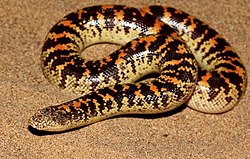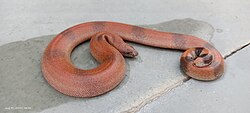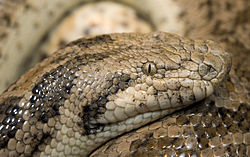Superregnum: Eukaryota
Regnum: Animalia
Subregnum: Eumetazoa
Cladus: Bilateria
Cladus: Nephrozoa
Superphylum: Deuterostomia
Phylum: Chordata
Cladus: Craniata
Subphylum: Vertebrata
Infraphylum: Gnathostomata
Superclassis: Tetrapoda
Cladus: Reptiliomorpha
Cladus: Amniota
Classis: Reptilia
Cladus: Eureptilia
Cladus: Romeriida
Subclassis: Diapsida
Cladus: Sauria
Infraclassis: Lepidosauromorpha
Superordo: Lepidosauria
Ordo: Squamata
Subordo: Serpentes
Superfamilia: Booidea
Familia: Boidae
Subfamilia: Erycinae
Genus: Eryx
Species (14): E. borrii – E. colubrinus – E. conicus – E. elegans – E. jaculus – E. jayakari – E. johnii – E. miliaris – E. muelleri – E. sistanensis – E. somalicus – E. tataricus – E. vittatus – E. whitakeri
Name
Eryx Daudin, 1803: 251
Type species: Eryx turcica Daudin, 1803 in error [=Boa turcica Olivier, 1801], by subsequent designation by Fitzinger (1843: 24).
Synonyms
Gongylophis Wagler, 1830: 192
Type species: Boa conica Schneider, 1801, by monotypy.
References
Primary references
Daudin, F.M. 1803. Histoire naturelle, générale et particulière, des reptiles : ouvrage faisant suite à l'Histoire naturelle générale et particulière, composée par Leclerc de Buffon, et rédigée par C.S. Sonnini. Tome Septième. L'Imprimerie de F. Dufart: Paris. 436 pp. + plates LXXXI–XCII. BHL Reference page.
Wagler, J.G. 1830. Natürliches System der Amphibien, mit vorangehender Classification der Säugetiere und Vögel. Ein Beitrag zur vergleichenden Zoologie.. J.G. Cotta'schen Buchhandlung: München, Stuttgart, & Tübingen. 354 pp. BHL Reference page.
Fitzinger, L. 1843. Systema Reptilium. Fasciculus primus. Amblyglossae. Braumüller et Seidel: Wien. vi + 106 pp. BHL Reference page.
Additional references
Noonan, B.P. & Chippindale, P.T. 2006. Dispersal and vicariance: The complex evolutionary history of boid snakes. Molecular Phylogenetics and Evolution 40(2): 347–358. DOI: 10.1016/j.ympev.2006.03.010 Paywall Reference page.
Reynolds, R.G., Niemiller, M.L. & Revell, L.J. 2014. Toward a Tree-of-Life for the boas and pythons: Multilocus species-level phylogeny with unprecedented taxon sampling. Molecular Phylogenetics and Evolution 71: 201–213. DOI: 10.1016/j.ympev.2013.11.011 Paywall Reference page.
Reynolds, R.G. & Henderson, R.W. 2018. Boas of the World (Superfamily Booidea): A Checklist With Systematic, Taxonomic, and Conservation Assessments. Bulletin of the Museum of Comparative Zoology 162(1): 1–59. DOI: 10.3099/MCZ48.1 Open access Reference page.
Eskandarzadeh, N., Rastegar-Pouyani, N., Rastegar-Pouyani, E., Zargan, J., Hajinourmohamadi, A., Nazarov, R.A., Sami, S., Rajabizadeh, M., Nabizadeh, H. & Navaian, M. 2020. A new species of Eryx (Serpentes: Erycidae) from Iran. Zootaxa 4767(1): 182–192. DOI: 10.11646/zootaxa.4767.1.8 Paywall Reference page.
Links
Uetz, P. & Hallermann, J. 2021. Eryx . The Reptile Database. Accessed on 24 April 2020.
Vernacular names
English: Sand Boas
Eryx is a genus of nonvenomous snakes, commonly known as Old World sand boas, in the subfamily Erycinae of the family Boidae.[2] Species of the genus are found in southeastern Europe, northern Africa, the Middle East, and southwestern Asia. Ten species are recognized as being valid.[2]
Description
The genus Eryx has the following characters. The head is not distinct from the neck. The dorsal surface of the head is covered with small scales. The rostral is large. The eyes range from small to very small, and the pupils are vertical. The anterior maxillary teeth and anterior mandibular teeth are longer than the posterior ones. The body is almost cylindrical. The dorsal scales are smooth or keeled. The tail is very short, either not prehensile or only slightly prehensile. The subcaudals are undivided.[3]
Distribution and habitat
Species of snakes of the genus Eryx are found in southeastern Europe, northern Africa, the Middle East, and southwestern Asia.[1]
Species
In addition to the species listed below, the genus Eryx formerly included three species which are now placed in the genus Gongylophis: Gongylophis colubrinus, Gongylophis conicus, and Gongylophis muelleri.
Nota bene: In the list below, a taxon author in parentheses indicates that the species was originally described in a genus other than Eryx.
| Species[2] | Taxon author[2] | Subsp.*[2] | Common name | Geographic range[1] |
|---|---|---|---|---|
| Eryx elegans | (Gray, 1849) | 0 | Central Asian sand boa | Southern Turkmenistan, northern Iran (the Kopet Dag mountains in the northeast and the Azerbaijan region in the northwest) and Afghanistan. |
Eryx jaculus |
(Linnaeus, 1758) | 0 | Javelin sand boa | Eastern Europe in Romania, Bulgaria, Yugoslavia, Albania and Greece (including Corfu and the Cyclades). The Caucasus. The Middle East in Syria, Israel, northeastern Saudi Arabia, Iraq and Iran. Africa north of the Sahara from Morocco to Egypt. |
Eryx jayakari |
Boulenger, 1888 | 0 | Arabian sand boa | From the east and south of the Arabian Peninsula north to Khūzestān Province in Iran. |
Eryx johnii |
(Russell, 1801) | 0 | Indian sand boa | From Iran through Pakistan into northwestern and southern India. |
Eryx miliaris |
(Pallas, 1773) | 0 | Dwarf sand boa | From the northern Caucasus and the north coast of the Caspian Sea east through Kazakhstan to the north coast of the Aral Sea and Lake Balkhash, though the Zaysan Valley to Sinkiang in China and southern Mongolia. Also in northern and eastern Iran, Afghanistan and western Pakistan. |
| Eryx sistanensis | Eskandarzadeh, N. Rastegar-Pouyani, E. Rastegar-Pouyani, Zargan, Hajinourmohamadi, Nazarov, Sami, Rajabizadeh, Nabizadeh & Navaian, 2020 | 0 | Sistan sand boa | Iran. |
| Eryx somalicus | Scortecci, 1939 | 0 | Somali sand boa | Somalia. |
| Eryx vittatus | (Chernov, 1959) | 0 | Northern Iran, Tajikistan, northern Afghanistan, northern Pakistan, Kyrgyzstan, and eastern China. | |
Eryx whitakeri |
Das, 1991 | 0 | Whitaker's sand boa | Southwestern coastal India in Kerala, Karnataka, Goa and southern Maharashtra. |
*) Not including the nominate subspecies.
T) Type species.[1]
Taxonomy
A new species, E. borrii, found in Somalia, was described by Lanza and Nistri (2005).[4] The specific name, borrii, is in honor of Italian zoologist Marco Borri.[5]
References
McDiarmid RW, Campbell JA, Touré T (1999). Snake Species of the World: A Taxonomic and Geographic Reference, Volume 1. Washington, District of Columbia: Herpetologists' League. 511 pp. ISBN 1-893777-00-6 (series). ISBN 1-893777-01-4 (volume).
"Eryx". Integrated Taxonomic Information System. Retrieved 7 July 2008.
Boulenger GA (1893). Catalogue of the Snakes in the British Museum (Natural History). Volume I., Containing the Families ... Boidæ ... London: Trustees of the British Museum (Natural History). (Taylor and Francis, printers). xiii + 448 pp. + Plates I-XXVIII. (Genus Eryx, p. 122-123, Figure 7).
Lanza B, Nistri A (2005). "Somali Boidae (genus Eryx Daudin 1803) and Pythonidae (genus Python Daudin 1803) (Reptilia Serpentes)". Tropical Zoology 18 (1): 67-136. (Eryx borrii, new species, pp. 95-98, Figures 15-18)
Beolens B, Watkins M, Grayson M (2011). The Eponym Dictionary of Reptiles. Baltimore: Johns Hopkins University Press. xiii + 296 pp. ISBN 978-1-4214-0135-5. (Eryx borrii, p. 32).
Further reading
Daudin FM (1803). Histoire Naturelle, Génerale et Particulière des Reptiles; Ouvrage faisant suite aux Œuvres de Leclerc de Buffon, et partie du Cours complet d'Histoire naturelle rédigé par C.S. Sonnini, membre de plusieurs Sociétés savantes. Tome septième [Volume 7]. Paris: F. Dufart. 436 pp. (Eryx, new genus, pp. 251–253). (in French).
Retrieved from "http://en.wikipedia.org/"
All text is available under the terms of the GNU Free Documentation License

